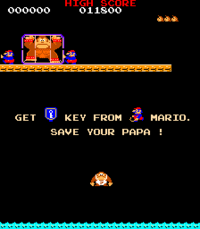Donkey Kong Jr. (game): Difference between revisions
mNo edit summary |
mNo edit summary |
||
| Line 49: | Line 49: | ||
*During the intro of the arcade version of ''Donkey Kong Jr.'', there were actually two Marios seen carrying Donkey Kong's cage away. | *During the intro of the arcade version of ''Donkey Kong Jr.'', there were actually two Marios seen carrying Donkey Kong's cage away. | ||
*This is the only game where Mario is portrayed as a villain, and it earned him the number 100 spot in IGN's Top 100 Videogame Villains. | *This is the only game where Mario is portrayed as a villain, and it earned him the number 100 spot in IGN's Top 100 Videogame Villains. | ||
* | *During the ending of the [[Nintendo Entertainment System|NES]] version of ''Donkey Kong Jr.'', when Mario falls, he dies. | ||
*The music for this game is redone and replayed in the [[Golden Temple]]. | *The music for this game is redone and replayed in the [[Golden Temple]]. | ||
Revision as of 22:24, January 5, 2013
It has been requested that this article be rewritten and expanded to include more information.
Template:Infobox Arcade Game Donkey Kong Jr. is an arcade game starring Donkey Kong Jr. that was later re-released along with other Mario games in Donkey Kong Classics, Donkey Kong Jr. + Jr. Math Lesson and Donkey Kong/Donkey Kong Jr./Mario Bros., remade into a Game & Watch game, which received a remake on the DSi and a Mini Classics game and was also later released on the Virtual Console for the Wii, and was available as a free download via the Nintendo 3DS Ambassador program. Donkey Kong Jr. is also a minigame in Game & Watch Galleries 3 and 4. The game was also released on the e-Reader with the only difference being a player had to scan in 5 cards to play it, afterward the player didn't have to scan the cards again unless they scanned in a different game requiring 5 cards. It was the direct sequel to Donkey Kong and it and the similar Donkey Kong II are the only games in the whole Mario series where Mario is the antagonist.
Donkey Kong Jr. never enjoyed the sales or the following that the original Donkey Kong did, but it did well enough to warrant a second sequel, Donkey Kong 3.
Story
After the events of Donkey Kong, Donkey Kong has been captured by Mario as revenge for kidnapping his girlfriend and Donkey Kong Jr. has to save him. Donkey Kong Jr. will travel through four stages from the jungle to the big city to get his father back, climbing vines, avoiding enemies and jumping on platforms along the way. However, every time Donkey Kong Jr. gets close to freeing DK, Mario just pushes him further away.
Finally in the big city, Mario is on top of a sky-scraper similar to 100m from the last game and Donkey Kong Jr. has to put six keys into their keyholes to free his dad and make the platform they're standing on disappear. Donkey Kong and Mario both fall down and Donkey Kong Jr. catches Donkey Kong but Mario just hits the ground. Donkey Kong Jr. carries his dad off-screen and then Mario gets up and runs after them, only to be punched right back out by Donkey Kong.
Levels
Characters
Enemies
Influence on Later Games
- Donkey Kong and Mario vs Donkey Kong: Donkey Kong Jr., as well as many enemies and gameplay elements, make an appearance in this game. Also, Mario's method of trapping Junior in Donkey Kong '94 is identical to Donkey Kong Jr.'s method of freeing his father from captivity. Many enemies and gameplay elements from Donkey Kong Jr. are reused in Mario vs Donkey Kong as well.
- Donkey Kong Country series: Diddy Kong and Dixie Kong's ability to climb two ropes at a time originates from Donkey Kong Jr.
Trivia
- During the intro of the arcade version of Donkey Kong Jr., there were actually two Marios seen carrying Donkey Kong's cage away.
- This is the only game where Mario is portrayed as a villain, and it earned him the number 100 spot in IGN's Top 100 Videogame Villains.
- During the ending of the NES version of Donkey Kong Jr., when Mario falls, he dies.
- The music for this game is redone and replayed in the Golden Temple.
Gallery
References
| Donkey Kong Jr. | ||
|---|---|---|
| Characters | Donkey Kong Jr. • Donkey Kong • Mario | |
| Enemies | Bird • Drop* • Egg • Nitpicker • Snapjaw • Spark | |
| Items | Fruit • Key | |
| Objects | Chain • Jump Board • Pole | |
| Rounds | Vine Scene • Jump Board Scene • Mario's Hideout • Chain Scene | |
| Other | Gallery • Media • Pre-release and unused content • Staff | |
